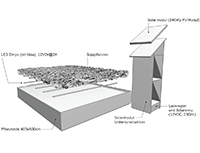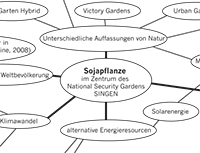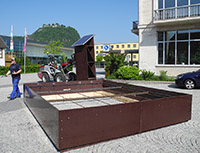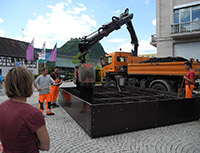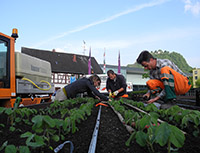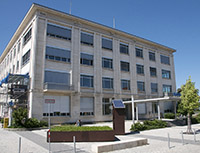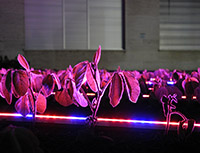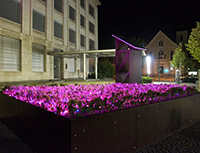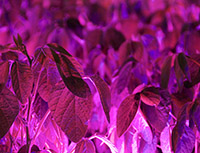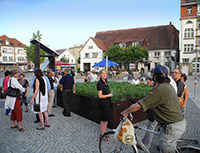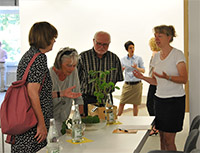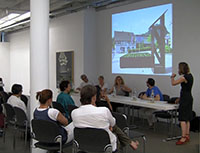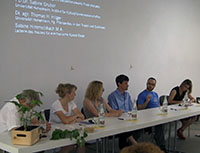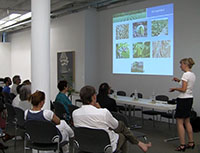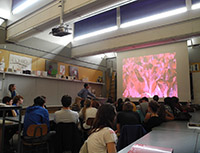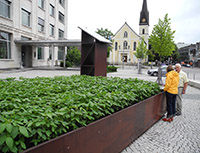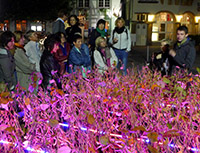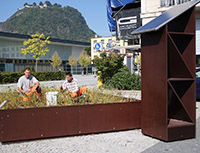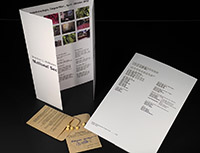Climate, energy, agriculture, national security. These issues of critical
contemporary concern are embodied in one ubiquitous plant: the soybean.
Yet, despite its growing significance, the soybean remains largely invisible
to consumers. The National Security Garden is a public art installation in
a hybrid form combining elements of agricultural fields and representational
gardens. It is based on critical gardening strategies which mobilize soybeans
to address global implications of food production and national security in a
post-surplus world. With this project McMullen_Winkler aimed to place soybeans
more vividly in the cultural imaginary of visitors by providing a form and
experience that can question how biotechnological and monocultural agriculture
shape, reject or revise ideas of national/homelands security and farming in
globally networked context.
From May to October 2012, with the curatorial assistance of artist Harald
F. Müller and the support of mayor Bernd Häusler the National
Security Garden was installed in form of a 200 square foot designed
field of soybean plants in front of the City Hall of Singen/Htwl. in southern
Germany. At night 1500 solar-powered magenta LED grow lights illuminated
the soybean plants from the ground up with energy harvested during the day.
McMullen_Winkler see this lighting design as both a utopian contribution to
Michael Pollan’s idea of "sun farming"1) and as a critical
reflection on the limits and possible pitfalls of technological interventions
in the natural environment.
Singen/Htwl. is located in Baden Württemberg, one of only two German states
(Bavaria being the other one) where soybeans are grown commercially, mainly
for Tofu production. McMullen_Winkler thus organized a series of events
that engaged the public and supported the discursive nature of the National
Security Garden public artwork and its goal to address issues at the
intersection of art, science and technology. These included: a public exhibition
opening with an artist talk; a symposium at the Städtische Kunstmuseum Singen
with the participation of Dr. agr. Thomas H. Hilger, University of Hohenheim,
Plant Production in the Tropics and Subtropics, (Germany); PD Dr. Sabine Gruber,
University of Hohenheim, Institute of Crop Science, (Germany); Sabine Himmelsbach
M.A., Director, House of Electronic Arts Basel (Switzerland); Frank-Thorsten
Moll M.A., Head of the art department, Zeppelinmuseum Friedrichshafen (Germany);
an artist talk at Friedrich Wöhler Gymnasium, one of the Singen high
schools; tours by Friedrich Wöhler Gymnasium high school students Fabian
König and Valentin Franke during the regional "Museumsnacht"
(night of the museums) and a public closing reception with a harvest event
and distribution of free project kits that contained the seeds of the
soybean plants from the garden. Even though the public artwork was a temporary
installation for the duration of only one summer, the idea of the project
kit with the included seed package was to have the National Security Garden
continue in the next season in the backyards and gardens of Singen and the
Lake Constance region with a new generation of soybean plants.
A detailed project chronology can be found on the
National Security Garden blog.
1) Journalist and food activist Michael Pollan proposes new
sunlight-based farming strategies (sun farming) as an alternative to
traditional oil-based farming practices. Pollan, Michael. "Farmer in
Chief", New York Times Magazine, Oct. 9, 2008.
